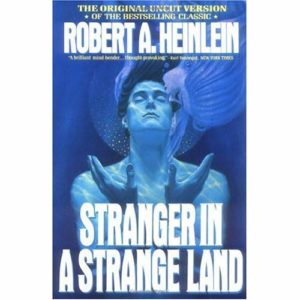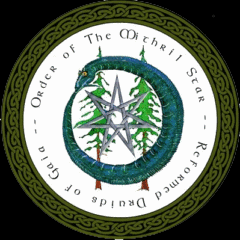Q: What is the relationship between the Order of the Mithril Star and the Reformed Druids of Gaia (RDG)?
A: OMS is the teaching order of the RDG. Our mission is to disseminate information on the Reformed Druid tradition, and helping to spawn new groves, as well as to correct some of the half-truths and distortions that have grown up about the Reform in recent years.
Q: “Grok?” “We are Gods?” “Waterbrothers?” What’s up with that?
A: This comes from Robert A. Heinleins novel, Stranger In A Strange Land (SiaSL). To briefly summarize the book, it’s  about a human born on Mars and raised by Martians who returns to Earth as an adult, becomes a messiah and starts his own religion. The main sacrament of that religion is water sharing , and the initiates are known as water brothers.
about a human born on Mars and raised by Martians who returns to Earth as an adult, becomes a messiah and starts his own religion. The main sacrament of that religion is water sharing , and the initiates are known as water brothers.
We are one of a handful of Pagan groups somewhat inspired by SIASL,in what has come to be known as The Heinleinian Tradition.The Order practices water sharing as a sacrament, encourages poly fidelity as a lifestyle, and recognizes that deity resides in each and every one of us (“Thou art God.”) In our Druid Path course we require students to read the novel (and they are tested on it).
Our embrace of Stranger In A Strange Land is unique within the RDG – we’re the only group within the Reform that does this.
Q: How can we take a group based upon a science fiction novel seriously?
A: OMS is not the first Pagan group to be INSPIRED BY (not BASED upon) that novel. The Church of All Worlds, Inc.(CAW), and the broader, “Heinleinian Tradition” were both inspired by SiaSL. David Fisher a founder of the Reformed Druids of North America) said (regarding some of the sources of Reformed Druidism): “I must admit we were all readers of science fiction or science fantasy.”
Scientists read science fiction. Many of them get a lot of inspiration from science fiction. A case in point is James Lovelock who authored the Gaea Hypothesis. This single hypothesis, the idea that the planet we live on is a single, interconnected organism, is the basis not only for the way science today looks at the planet, but for much of Pagan spirituality. Lovelock’s biographer says that not only was he inspired by science fiction, but he read Stranger In A Strange Land many times.
OMS is, however, inspired by more than just that one book. It also contains elements from Reformed Druidism, Faery Wicca, Discordianism, Ceremonial Magick, Shamanism, and Metaphysics – all blended together into a unique expression of spiritual practice.
Besides, the AWEN /|\ can come to us in a myriad of forms, and who is to judge that one form is any more or less legitimate than another?
Should any of these groups be taken seriously? We can’t speak for CAW, but we of the OMS would be appalled to know someone was taking us seriously. “That way leads to the dark side.” –Obiwan Kenobe
Q: Why do you use Heinlein’s novel, Stranger In A Strange Land in your Reformed Druidism course? What has it got to do with Druidry anyway?

A: This novel spoke to the founders of the Order of the Mithril Star, to whom the idea of a community of men and women bound in perfect trust and perfect love (through the symbol of water), and the discovery of our own God-ness was a very compelling one. So the founders set about to create just such a community, and brought many of the theological, philosophical and liturgical ideas from the novel into their new construction.
SiaSL has nothing whatsoever to do with Druidry, rather, the ideals of the novel have been integrated into a new interpretation of Druidry, very consistent with the spirit of the Reformed Druids — The Order of the Mithril Star.
Q: So then, you consider ‘Stranger In A Strange Land’ to be some sort of “holy Writ,” but Reformed Druids have no sacred texts, therefore you are not really Reformed Druids!
Q: I’ve read elsewhere on the web that you disparage Libertarians and in fact, embrace a Socialistic, even Marxist, world view. How can you be such fans of Robert Heinlein then?
A: Let’s see: humans are an interdependent part of Gaia. If one part of Gaia suffers, then the whole system suffers. We are God (or you could say that we are drops of water in the ocean that is God). Is that socialistic? Maybe. As for Heinlein: just because you admire someone doesn’t mean you have to agree with everything that person believed. Heinlein was human. He made mistakes. He also wrote great fiction.
Libertarianism, Randism and Objectivism are political cults, and operate pretty much the way all cults (and fundamentalists) operate. So we reject them for the same reasons we reject Scientology. Besides, these BS’ (belief systems) are based on observable falsehoods: 1) Man is not independant from the rest of the world – man is interdependent. 2) Individualism is not the natural state of human beings, rather, tribalism (or collectivism) is. 3) Selfishness (the basic fool-osophy underskirting Libertarianism) sucks.
Q: So a self-identifying libertarian could not join the Order of the Mithril Star?
A: They could, but I don’t know how they would get past our Pledge, which all new members are required to take and subscribe to. In particular, the phrases, “…from each according to his/her abilities, to each according to his/her needs,” and, “… the good of the many outweighs the good of the few.” These ideals are the very antithesis of libertarianism. So they could join, but they wouldn’t remain Libertarian for very long..
Q: Are Druids polytheists or pantheists? Monotheists?
A: Yes. All of the above. None of the above. It’s not really that cut and dried.
The ancient Celts seem to have been polytheists. There are many gods and goddesses identified with the Celts. After the Gauls, Belgae and Britons were conquered by the Romans, there were hybrid forms. Or, at least, there were inscriptions pairing the names of a Roman god and a Celtic god. Also the type of belief varies e.g.: are the gods real or are they metaphors?; is faith authoritative or individual?, etc. This can be a very sensitive subject. Agnostic types and true believer types can hurt each other’s feelings without even meaning to.
Mithril Star Druids believe “Thou art God.” We are all God and God is all of us. We categorize the Gods into three divisions: The Archetypes – those Gods of old who we know from mythology; The Old Ones — Gods who once lived on earth in human bodies (a deceased uncle or aunt might well be one); and US – you, me, and everyone else.
Q: What does it mean, “Thou art God”?
A:The word “God” designates the supreme being (or corporate beings) of a given pantheon and really means “deity.” Thus, “Thou art God” means “Thou art deity”. This (BTW) is a higher designation than “namaste” or the Quaker concept of “that of God in all men” (where again, “men” includes women). Because it’s not that you have a bit of God in you, it is that you are God. You are the beginning and the end. The first and the last. The Alpha and the Omega. The universe revolves around you, and you are the universe. You are love, and he who abides in love abides in you and you in them.
At the same time, everyone you meet is God too, and so are all the animals, all the plants, all the tiny organisms that have life: all is God, God is all. We eat God everyday, in every way. We eat and breathe and wear and make love and manipulate and function within and as God.
Q: So you’re all Gods then. Isn’t that considered “Left Hand Path”?
A: Well, “Left Hand Path” (LHP) is really just a polite way of saying “Satanist.” But I see where you are coming from here. The answer is NO, and here’s why: We don’t say that we are Gods (individual, autonomous deities), we say we are God, which means we are a collective deity, non existent without each other. We very rarely, if at all, say “I am God,” but rather “Thou art God.” The difference is profound and it celebrates our interdependence with all the other species on Earth, in the Universe, and with the Universe itself. In our present, physical existence, we are cups of water dipped from the ocean. Each cup is individual while separated from the ocean, yet each cup bears all of the same characteristics that the water in the ocean bears. But once a cup is poured back in, becomes a part of the whole once more, and looses it’s identity for a time, until it becomes separated again. In other words, we can never be God individually, but only as part of the collective God.
We use Star Trek metaphors to teach these concepts from time to time. So think of the villain race of Star Trek Deep Space Nine, The Founders, of which Constable Odo was one (other races subordinate to them even called them “Gods”). Remember that when Odo rested, he stayed in liquid form in a bucket – this was his natural state of being. When Odo became sick and was unable to keep his form, he was taken back to his home planet, which from space looked like one huge ocean. In order to be cured Odo had to be reunited to his people in what they called “The Great Link.” This was the ocean that was seen from space – the vast collective of beings, whose bodies, souls and minds were united in one vast collective that covered the planet.
This is not a new idea however, and in fact it’s at the heart and soul of Kabbalah, the ancient system of Jewish mysticism. In explaining this idea, Stephan Gabriel once said that, “We are all microprocessors on the great mother board of the universe.” And that is the reason, as Stephan once pointed out, the OMS is neither LHP or RHP, but rather a path of the Middle Pillar.
Q: What is your relationship to the RDNA?
Q: What is the relationship between the RDG and the RDNA?
A: Distant cousins perhaps? Actually, none what-so-ever. Although there are a handful of RDG 3rd Degree (Priest(ess))s that hold the RDNA 3rd Order, the general rule of thumb is that we do not, nor are we seeking it, or the “Apostolic Succession” that comes with it. Basically, we were inspired by the RDNA, and much of our tradition and liturgy are derived from the RDNA, but we are not of the RDNA.
Q: So do all Druids have to practice naturism and polyfidelity?
A: Absolutely not! No one is compelled to do anything they don’t want to. You don’t have to practice those lifestyles, you get to!
Q: Isn’t that just like a cult where the leader gets to have sex with all the women?
A: The leader, along with all the other members, do indeed get to have sex with all the women, or men, or both, that choose to do that. They don’t have to — they get to! But in this respect we’re really no different than any other Pagan group. This is usually trotted out as a straw-man by our critics to distract from their own hangups. Frankly, if this is what a person thinks, then they are probably not OMS (or really, Pagan) material in the first place, and should probably join a group that is more suited to their proclivities, such as a fundamentalist sect within one of the Abrahamic faiths (I understand Fred Phelps is recruiting members for his cult.)
Q: What is a Grove?
Q: In the old days they say it took nineteen years to train a Druid, how can you do it in 19 weeks?
A: Actually we don’t. The Druids education begins when he or she decides to be a Druid. From that point it never ends. The world has changed a lot over the last few thousand years. In ancient times it took nineteen years to become a Druid, but this course of training included many of those subjects that we learn today at school. And nineteen years is also a symbolic length of time: it represents a Metonic cycle: a calculation of the time between two almost identical eclipses, and a calculation which also succeeded in uniting the solar and lunar calendars. And so nineteen years symbolizes the time it might take for someone to unite the sun and moon, the Masculine and the Feminine, within their beings.
Today it still takes a long time to achieve this union in the depths of our souls, and the study of Druidry is a lifetime pursuit for many. But we no longer need to train for nineteen years before we can call ourselves a Druid. In fact the term Druid has now come to denote, for many, the type of spirituality they follow.
Q: How do you become a Druid?
A: Do you believe that “Nature is good?” Then you already are one. Forget all the nonsense about studying for 20 years. It may be that the Druids of old did so. It is not how the Druids of today think (well, a few nay-saying curmudgeons say it HAS to that way, but thankfully, reasonable people
prevail). The fact is that the study begins when you become a Druid, and never ends. Actually there is one more way to become a Druid: take a hike or camp (or better – both) in the forest, particularly the redwoods. Spend a week at least if you can spare it. Talk to the trees. Touch them. Hug them. Meditate with them. Stay up all night with them. View the stars through their canopy. You’ll learn more that way then from all the online classes we could ever come up with.
Q: This doesn’t seem all that consistent with the Reformed Druids.
A:Actually it’s very consistent. All groups within the Reform are autonomous. They are allowed to add, subtract, change, rewrite, etc., pretty much anything they wish, so long as they include the two tenets in their general philosophy.
This means that new ideas, and precedents, are encouraged, and even traditional. For example, when OMS joined the RDNA back in 2002 as a group, that set a new precedent, as a large group had never before joined the RDNA that way before (On the other hand, the ruling body of RDNA in the end decided that we could not, and the Matriarch of the Order then declared us to be “in schism” from the RDNA, so YMMV). This is how the Reform has evolved beyond it’s beginnings as a student protest at a small Midwestern college. This tradition of embracing new precedents is one of the beautiful things about the Reform. The RDG continues this tradition of “doing religion the old fashioned way: we’re making it up as we go!” For that matter that is exactly what he ancient Druids did as well, which is of course no different than any other religion, spirituality, or philosophical path.
The Reform is largely Discordian in orientation: “A non-prophet, ir-religious, dis-organization,” you might say.
Q: Why is the head of your Order called the “Patriarch”? Isn’t that
rather “Patriarchial”?
A:This is an old tradition that goes back to the RDNA. The male leader of an Order is called the Patriarch. If the leader is a female, she is called the Matriarch. We assume that this is to distinguish this role from that of Archdruid, but the ARDA doesn’t go into it anywhere. Our present Patriarch,
Ellis Arseneau, has stated that when he retires he will name a woman (a Matriarch ) to lead the Order. She will be someone who lives in the Redwood region of California, and is a practicing naturist involved in a polyfideltous Nest, within an intentional community. In other words, she will be practicing ALL of our principles.
Update: In Geimredh 07, Ellis did in fact resign, and named his wife Ceridwen as Matriarch. There was some controversy about this. Ellis had placed an ad in many Druid groups, asking for a “bi-sexual, polyamourous, naturist, woman who was able to relocate to Eureka CA to be mentored and attain the title of OMS Matriarch.” This was interpreted by some, even within the RDG (WHO SHOULD HAVE KNOWN BETTER), as basically “fishing for pussy.” Fact is, very few members of OMS practice the lifestyle, so Ellis felt that maybe he could find someone outside the Order. Kind of a silly thing really, but in the end, rather than answer to all this none sense, he made the one woman he knew was polyamorous, naturist and bi-sexual (his wife and current Archdruid of the Mother Grove (Senior Archdruid), Matriarch of OMS.
Q: You don’t really seem very Celtic oriented.
Q: Well then, ok, so how do I join?
A: Well first, you need to join our parent group, the Reformed Druids of Gaia (CLICK HERE, it’s off site). Then return here and CLICK HERE).
